|
|
||||||||||||||||||||||||||||||||||||||||||||||||||||||||||
|
Please sign my Guestbook and leave feedback |
||||||||||||||||||||||||||||||||||||||||||||||||||||||||||
|
Recent Additions |
||||||||||||||||||||||||||||||||||||||||||||||||||||||||||
|
|
||||||||||||||||||||||
|
Adel was given to Ilbert de Lacy who fought with William the Conqueror at Hastings. He founded Pontefract Castle which was itself to have a colourful history over the centuries until Cromwell ordered its destruction in 1649. Ilbert gave Adel Manor to Ralph Paynel and he gave the church to the monastery at York. They replaced the Saxon church in 1159 and that is the church we mostly see today. Until the Viictorian era the church was more or less untouched apart from the inevitable insertion of some rectangular windows on the south side in the c16. The carvings are the big draw here, The south door is one of the finest Romanesque compositions in England. Tragically, it was limewashed in a well-intentioned attempt at preservation. Apparently the advice given by the conservation experts was misunderstood. The chancel arch carvings are amongst the finest and there is a very large, well-preserved corbel table, although as with most in Yorkshire its subject matter is a little uninspired. If you are interested in Norman carving you have to make a trip to Adel. |
 |
 |
|||||||||||||||||||||||||||||||||||||||||||||||||||||
|
Norman Treasures. Left: The South door. The canopy is modern. Right: Looking towards the east end and the magnificent chancel arch. The triple east windows, although Norman in appearance, in fact date from the late c19. They replaced a previous prependicular-style window. |
||||||||||||||||||||||||||||||||||||||||||||||||||||||
 |
 |
|||||||||||||||||||||||||||||||||||||||||||||||||||||
|
Left: The view towards the west end through the chancel arch. Like the east windows, these are not original. They were reconstructed by the Victorians and had already been enlarged in 1718 to accommodate a west gallery. Right: This is a replica of the original sanctuary knocker. Sadly, it is not a replica because the original is in a museum, but because the original was stolen in 2002: an appalling act of vandalism. It was cast in bronze in York in AD1200. |
||||||||||||||||||||||||||||||||||||||||||||||||||||||
 |
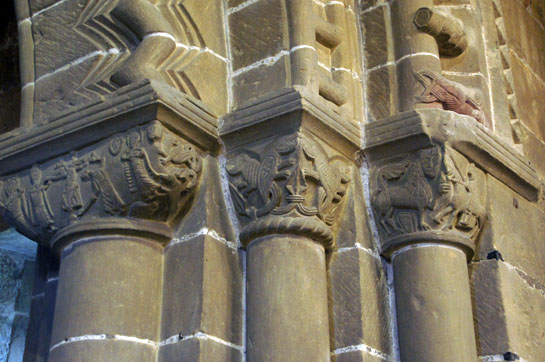 |
|||||||||||||||||||||||||||||||||||||||||||||||||||||
|
The chancel arch capitals. The north (left) shows Sagittarius shooting a dragon with his bow then two pairs of beasts. Underneath the arch itself is a scene of the baptism of Christ. On the south (right) we have a splendid mounted Norman knight facing a Lion of Judah. Then, as on the north side there are two pairs of beasts. As on the north side we have under the arch itself a biblical scene, in this case the death of Christ. There is, therefore, a symmetry of themes between the two sides. |
||||||||||||||||||||||||||||||||||||||||||||||||||||||
 |
 |
|||||||||||||||||||||||||||||||||||||||||||||||||||||
 |
 |
|||||||||||||||||||||||||||||||||||||||||||||||||||||
|
The two northernmost capitals. Sagittarius, of course, is best known today as an astrological symbol. He is a centaur - half man, half ass or horse and occurs in the mediaeval bestiaries. Sagittarius, one of the most ubiquitous of symbols in Norman iconography, can be taken to symbolise double-dealing men that are seen to be good but conceal evil behind. In Norman iconography he variously grapples with dragons (as here at Adel), with savages in lions’ skins, and with lions. Sagittarius represents the soul that overcomes the flesh. Fascinatingly, here at Adel (top right) the tail of the centaur is itself under attack from a devilish dragon behind, doubtless reinforcing the concept of good and evil, soul and flesh in conflict. |
||||||||||||||||||||||||||||||||||||||||||||||||||||||
 |
||||||||||||||||||||||||||||||||||||||||||||||||||||||
 |
||||||||||||||||||||||||||||||||||||||||||||||||||||||
|
The Baptism of Christ. This is a fascinating composition. In the picture left we can see a somewhat oversized angel flying in with a chrisom - a white robe or cloth worn at baptism. Beneath the angel, however, the Devil is trying to drink the baptismal water, On the right we can see the Christ with John the Baptist. Overhead a dove descends symbolising the Holy Spirit. To John’s right is King David breaking of a branch from the Jesse Tree. |
||||||||||||||||||||||||||||||||||||||||||||||||||||||
 |
 |
|||||||||||||||||||||||||||||||||||||||||||||||||||||
|
Now for the southern capitals. Left: The Lion of Judah. Both King David and Jesus were of the Tribe of Judah, Judah being the fourth son of Jacob. In Revelations Jesus himself is referred to as the Lion of Judah. Right: The knight is a Christian as shown by the cross on his Norman kite-shaped shield. We can be assured that in this case he has no martail intentions towards the lion! Compare this representation of a Norman knight with the somewhat earlier one at Wakerley in Northamptonshire. Of course, the concept of the Norman knight as a champion of Christianity was in stark contrast with their treatment of the Anglo-Saxon population whom they conquered. Adel would have been part of William’s “Harrying of the North” in 1069 when Sweyn II of Denmark had invaded England and united with Edgar of Wessex to upset Norman rule in the north. William proceeded to devastate the land north and west of York in order to isolate his enemies. Typically, William was able to buy off the Vikings who would have sold their grannies for a few arm rings of silver! Much of the north had not recovered twenty years later, however. |
||||||||||||||||||||||||||||||||||||||||||||||||||||||
 |
 |
|||||||||||||||||||||||||||||||||||||||||||||||||||||
|
Left: Two pairs of monsters. Compare them with those on the south side and note that the second monster from the left has a body in the form of a soldier’s shield bearing a design of the cross. No ordinary monsters, these then. Right: The right hand side of the crucifixion scene. |
||||||||||||||||||||||||||||||||||||||||||||||||||||||
 |
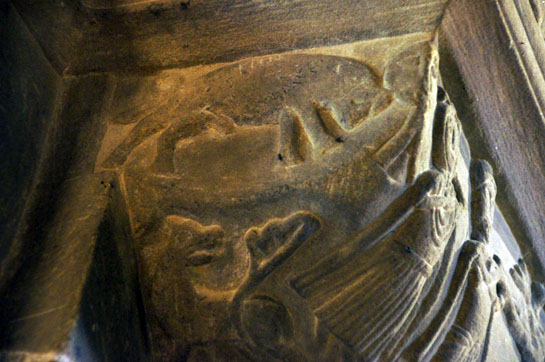 |
|||||||||||||||||||||||||||||||||||||||||||||||||||||
|
Left: Christ is being removed from the cross by Joseph of Aramathea and Nicodemus. Right: On the inner side of the crucifixion scene there is what the Church Guide describes as a hunting dog (below) and a boar (above). The boar is rather odd in that the boar is shown in “counter relief” - that is, the image is sunken into the stone rather having had the surrounding stone removed so that it stands “proud”. |
||||||||||||||||||||||||||||||||||||||||||||||||||||||
 |
||||||||||||||||||||||||||||||||||||||||||||||||||||||
|
Adel Church is a “celebrated” example of English Romanesque architecture so it is blessed with frequent visits from “experts”, university professors and the like. They do, therefore, get a great deal of information about their church. The chancel arch beakheads at Adel are the most interesting I’ve ever seen and the church has been able to describe each one in its Guide Book. Normally I wouldn’t bother to reproduce a whole beakhead run because it wouldn’t be worth it but for Adel I am making an exception. The descriptions are taken from the Church Guide. So here (above) are the first six. The Interesting ones are: 2nd Left: “Cannibal with lower part of male baby in mouth”. 4th Left: “Devil with cats’ ears swallowing twins, rear view”. Well it looks like a lego figure to me! |
||||||||||||||||||||||||||||||||||||||||||||||||||||||
 |
||||||||||||||||||||||||||||||||||||||||||||||||||||||
|
4th from the Right: “Cannibal eating lower part of body/reflection face”. 3rd Right: Devil with Cats’ ears and & ring in lower lip. 2nd Right: “Devil...lower half of baby on tongue”. Far Right: devil...side of baby gripped by teeth”. Are you beginning to pick up a theme here...? |
||||||||||||||||||||||||||||||||||||||||||||||||||||||
 |
||||||||||||||||||||||||||||||||||||||||||||||||||||||
|
Far Left: “Pointed head with tiny baby on tongue”. 2nd Left: Smiling Devil (really?)..top half of baby dangling from teeth. 3rd Left: Toothless granny with striped scarf. (It’s good to see a sense of humour!). 4th Left: “...eating legs of twins”. 5th Left: “...with fish on a square tongue. 6th Left: “Rabbit creeping out of a hole” (Thank God they’ve taken a break from eating babies!) 7th Left: ...trying to eat a hippo’s head” (?) |
||||||||||||||||||||||||||||||||||||||||||||||||||||||
 |
||||||||||||||||||||||||||||||||||||||||||||||||||||||
|
2nd Left (The arch centre): “Musician with pointed shoes holding a bow and vielle with 3 strings and a face on the base. 5th Left: ....with teeth gripping back of small goat”. 7th Left: “Sad green man”. |
||||||||||||||||||||||||||||||||||||||||||||||||||||||
 |
||||||||||||||||||||||||||||||||||||||||||||||||||||||
|
3rd Left: “The owl and the pussycat” (!) 4th Left: Two pike on a square rock. |
||||||||||||||||||||||||||||||||||||||||||||||||||||||
 |
||||||||||||||||||||||||||||||||||||||||||||||||||||||
|
A bit of a shared theme again here with lots of shared/multiple heads. Far Right: “Upside down boy with outstretched arms and arch on shoulders”. Arch? |
||||||||||||||||||||||||||||||||||||||||||||||||||||||
 |
||||||||||||||||||||||||||||||||||||||||||||||||||||||
|
And finally (phew... not sure this was a good idea after all!) Far Left: “Devil eating a horsehead”. Far Right: Bearded face with tongue & necktie” (!). |
||||||||||||||||||||||||||||||||||||||||||||||||||||||
 |
 |
 |
 |
|||||||||||||||||||||||||||||||||||||||||||||||||||
|
Four Beakheads |
||||||||||||||||||||||||||||||||||||||||||||||||||||||
 |
||||||||||||||||||||||||||||||||||||||||||||||||||||||
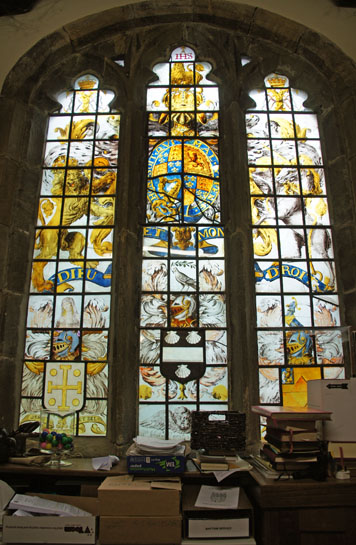 |
||||||||||||||||||||||||||||||||||||||||||||||||||||||
 |
||||||||||||||||||||||||||||||||||||||||||||||||||||||
|
Left: The church has a north side vestry full of old photographs and press cuttings that visitors are invited to look at. I was very interested in this east window. This window was made in 1681 by Henry Giles of York and it shows the royal arms of Charles II. Charles, of course, was the Restoration king and all churches were enjoined to show their loyalty and we have to remember that the perceived catholicisation of England by Charles I was one of the causes of the Civil War. So these shows of loyalty must have seemed important to his son. The window was placed in the east end of the chancel but was moved to the vestry when the Victorians installed Norman-like lancet windows. Top Left: The font cover that has been attributed to Eric Gill. If you have never heard of Mr Gill (1880-1940) you might have heard of one of his “inventions”: the Gill Sans typeface that seemed to be everywhere before computers filled our world with novel and mostly hideous fonts. “Perpetua” is another Gill typeface. Eric Gill was also a noted sculptor and engraver. He was noted for some less savoury reasons too - see the footnote below. Bottom Left: The Norman octagonal font on its more modern base. |
||||||||||||||||||||||||||||||||||||||||||||||||||||||
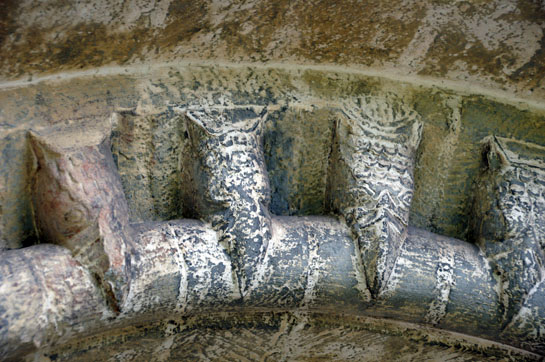 |
 |
|||||||||||||||||||||||||||||||||||||||||||||||||||||
|
Left: Adel boasts another course of beakheads around its south door. As with the rest of the doorway composition, the combination of blackened stone and lime wash produces a rather unfortunate effect. There are forty and the Church Guide says that it represents Christ’s forty days in the Wilderness. I don’t know the source of this. It seems to me that Christianity can find a Biblical symbolism for just about every number you can think of! Interestingly, Adel’s chancel arch has only thirty eight. Tickencote’s chancel arch, on the other hand, also has forty. Elkstone’s south door has only sixteen. Iffley has two courses, one of fifty-one and one of fifty-nine so I am afraid that the evidence simply doesn’t support the assertion. Right: The tympanum. As with Norman fonts, tympani range from the sublime to the literally ridiculous. This is one of the better ones and there is no ambiguity about what it represents. The Lamb of God is at the apex. Christ is immediately below that sitting on his throne. He is flanked by the Four Evangelists, from left to right Luke, Matthew, John and Mark. To the left and right of the Lamb are the Sun and Moon. In the corners either side of the Evangelists are snakes. |
||||||||||||||||||||||||||||||||||||||||||||||||||||||
 |
 |
|||||||||||||||||||||||||||||||||||||||||||||||||||||
 |
 |
 |
||||||||||||||||||||||||||||||||||||||||||||||||||||
 |
||||||||||||||||||||||||||||||||||||||||||||||||||||||
 |
 |
|||||||||||||||||||||||||||||||||||||||||||||||||||||
|
Top Left: The Agnus Dei. You can see the halo around His head and also the banner above His back. There is a badly weathered cross at the apex. Top Right: Christ on his throne. Centre Left: Luke, the Winged Ox. Centre: Matthew in human guise. Centre Right: St John as an eagle. Lower Left: St Mark as a winged lion Lower Centre and Lower Right: Snakes.. |
 |
||||||||||||||||||||||||||
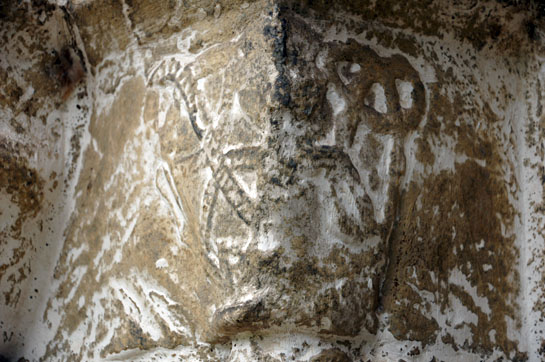 |
||||||||||||||||||||||||||
|
Left: The west capital of the south doorway with an interlaced ribbon design. Right: The north capital is very badly weathered. You can just see the outline of a beast on the right hand side. |
||||||||||||||||||||||||||
 |
 |
|||||||||||||||||||||||||
 |
||||||||||||||||||||||||||
 |
||||||||||||||||||||||||||
 |
||||||||||||||||||||||||||
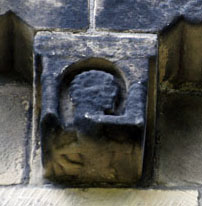 |
||||||||||||||||||||||||||
|
The Corbel Table. The top two pictures give a flavour of the whole: mainly grotesque heads. The majority of Yorkshire corbel tables seem to be of this ilk. There are alwats exceptions, however. Above Left: The corbel table at Adel has several examples of this rather odd design of a head enclosed in an arch but with a crudely-drawn body on the underside. Above 2nd Left: The Ram is one of the most ubiquitous images on corbel tables in England. As such, we must assume that it does not appear just because masons liked rams! The most widely-accepted theory is that it is a symbol of Christ. Abraham sacrificed a ram instead of his son, Isaac. In the same way, God sacrificed his son for the sake of mankind. Above 2nd Right: Many corbel tables have images of men playing musical instruments. Quite what this one is, I am not sure. It most resembles South American-style pan pipes. Far Right: A sheep? You decide! |
||||||||||||||||||||||||||
 |
 |
|||||||||||||||||||||||||
|
Left: The gable of the west end has this group of nine grotesque carvings. I think it is fair to say that is an early example of the sheer impenetrability of the motives of the mediaeval masons where external decoration is concerned. Corbels are there to help support the roof but we don’t know why it was necessary for many (but by no means all) Norman corbel tables to have carved decoration that was, as here at Adel, of little or no spiritual significance. “Because they could” sounds facetious but, to my mind, most likely to be the truth of things. Yet at Adel they went further and added these grotesque heads below the gable when they don’t even function as corbels! Right: The south side of the chancel showing the corbel table and also the Norman priest’s door. |
||||||||||||||||||||||||||
 |
 |
|||||||||||||||||||||||||
|
Left: The Norman window at the top of the wall at the west end of the church. Right: The vestry, as at so many churches, mars the appearance of the north side - especially that gruesome chimney! Adel stores some of its old photographs and relics there and they allow visitors to see them so perhaps we shouldn’t be too hard on them. Note that unusually they have a large and decorative window at the east end and this is the Restoration window shown earlier on this page. Note also that the corbel tables at Adel is unusually complete. It covers both chancel and nave on both sides and even the vestry has not interrupted it. |
||||||||||||||||||||||||||
 |
||||||||||||||||||||||||||
 |
||||||||||||||||||||||||||
|
Left: The east end with its three faux-Norman Victorian windows. Right: The entrance to the churchyard has this collection of millstones and stone coffins! |
||||||||||||||||||||||||||
 |
||||||||||||||||||||||||||
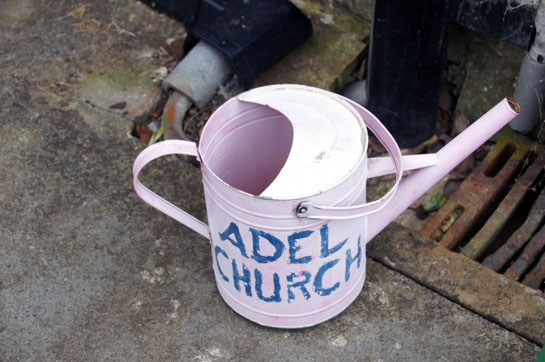 |
||||||||||||||||||||||||||
|
Two pieces of Adel ephemera. The shoes with flowers were there because we visited not long after their St John’s Day celebrations - June 24. |
||||||||||||||||||||||||||
|
Footnote - Eric Gill |
||||||||||||||||||||||||||
|
When Rolf Harris was convicted of paedophilia, some private collectors and art galleries hastily removed or even destroyed his artwork. A columnist in the Times wrote an article pointing out that the world seemed quite happy to carry on displaying the works of Eric Gill. When the volunteer guide in Adel Church asked if I had seen the font cover that is attributed (not, it must be said, definitively) to Gill I asked “Is it decent?” Gill produced work on many subjects and in many media. His nudes are extraordinarily sensual. Unfortunately, his own diaries tell us that he was an adulterer, that he was sexually abusing his own children and that he was having an incestuous relationship with his sister as well as abusing his pet dog. He was also a staunch Roman Catholic. Does this invalidate his art? Well you will have to make up your own mind! A lover of wood engravings, I have a small book of his work. Looking at it or not cannot change the past. Would I have that book if he was still alive and if I knew about him what we know now? No, I wouldn’t. Even when I look at his work now I feel a slight feeling of shame. |
||||||||||||||||||||||||||
|
|
||||||||||||||||||||||||||
